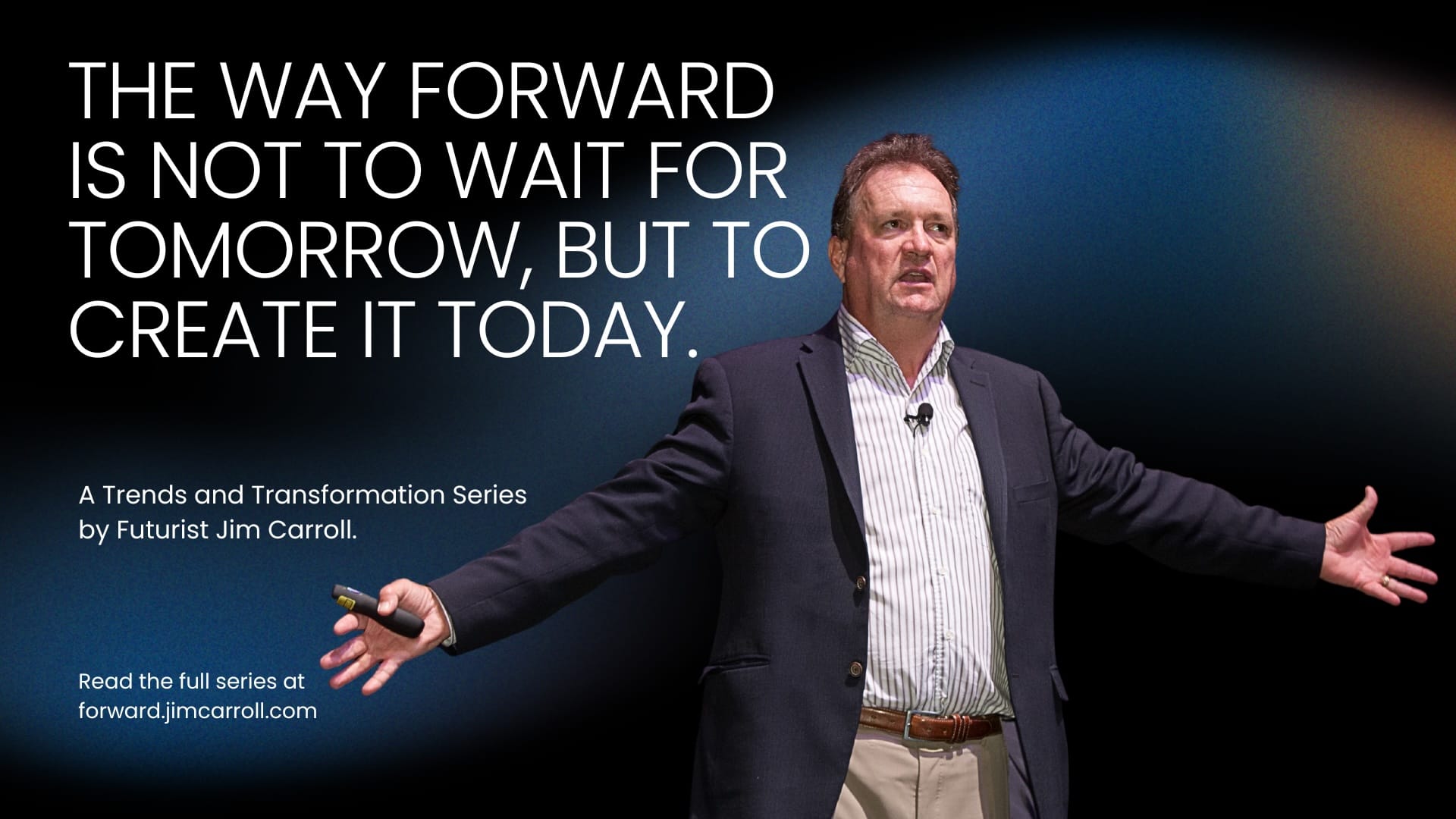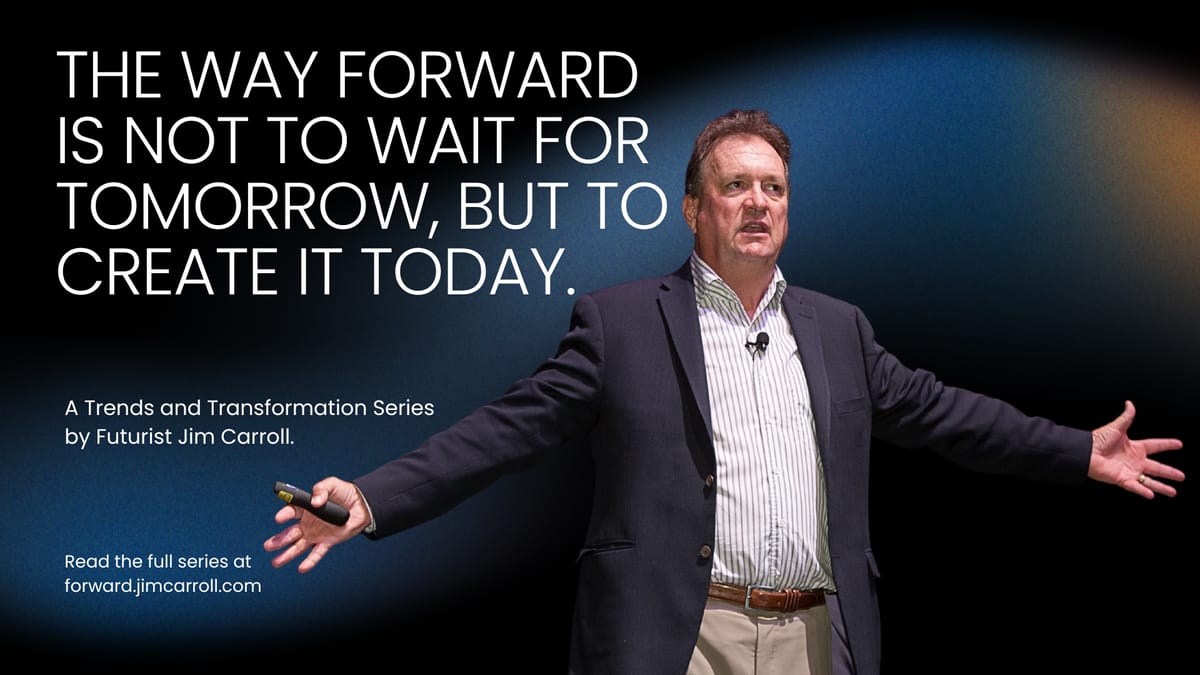"The way forward is not to wait for tomorrow, but to create it today." - Futurist Jim Carroll

In 2025, the headwinds are severe, and the path forward seems shrouded in fog. We’re living through one of the most volatile and unpredictable periods in recent memory. With that being the case, Jim wrote new series, The Way Forward: A Trends and Transformation Series, taking a look at the trends redefining industries, and actionable strategies organizations must pursue to align with these realities. The entire series can be found at forward.jimcarroll.com
In this series, I covered major trends in 9 major industries, taking a look at what will define those industries, the path forward and the barriers in the way. You'll find the entire series at forward.jimcarroll.com. I also tried to outline a series of bold actions that could be pursued in each industry for those eager to find a way forward.
What's the overall picture? As I noted in the introduction, the future is no longer a distant destination but a "high-speed operating system we must run on and align to every single day". I've also indicated that the instinct to "hunker down and wait it out" during volatility is a trap; clarity must be created through action.
What I've tried to do is provide a clear, action-oriented guide for leaders in any sector to navigate the present chaos and thrive.
So how do I wrap it up? Let's take apart the universal forces of disruption that surrounds all nine industries and the common theme across those trends. There are 3 big overriding themes.
1. The Acceleration of Intelligence and Time
This theme is the speed at which everything is now operating. Time itself is collapsing. That's a consistent message across all industries, and it's being driven by several common core trends:
- AI and Data as the New Engine: Artificial Intelligence (AI) and Big Data are shifting every sector from reactive/historical models to predictive/real-time intelligence. This includes AI-driven diagnostics in healthcare, fraud detection in insurance, and demand forecasting in retail.
- Velocity of Science and Innovation: Medical knowledge is doubling in months, not years. Manufacturing product lifecycles are collapsing, demanding the "velocity of continuous reinvention". New technologies are arriving faster in agriculture and retail, requiring that people in those industries learn to innovate at speed.
- The Connected Ecosystem (IoT): Hyper-connectivity and the Industrial Internet of Things (IIoT) transform physical assets (factories, farms, vehicles, medical devices) into rolling data centers that enable real-time visibility and control.
Here's the key trend underling the trend - over time, it's only going to get faster!
2. The Reinvention of Physical Reality and Value Chains
The second underlying trends involves a change in how products and services are physically created, delivered, and consumed.
- Personalization at Scale: Mass production is yielding to Mass Customization. This is seen in manufacturing (make-to-order), food production (vertical farming), and healthcare (personalized treatment plans).
- Virtualization of Assets: Technologies like Digital Twins create virtual replicas of factories, products, and buildings to act as risk-free testing environments for lifelong management. Healthcare is pivoting to the Virtualization of Care with connected devices extending the hospital's reach into the home.
- End-to-End Robotics and Automation: Robotics and autonomous systems are moving beyond the factory floor to the farm (driverless tractors), the job site (brick-laying robots), and the customer (autonomous last-mile delivery).
3. The Empowerment of the Customer and Planet
The third involves subtle changes that shift everything to a new focus:
- The Ascendant Customer: Consumers (especially Millennials and Gen Z) are now digital-native, expecting Amazon/Netflix-level convenience, and demanding transparency, sustainability, and value alignment from brands. They have become active participants (prosumers) in their energy, financial, and health care.
- The Circular Economy: The focus is moving beyond net-zero to Climate-Positive Tech. New paradigms eliminate waste through resale, rental, repair, and recycling models. Construction and manufacturing are adopting "design for deconstruction" to reuse materials.
- New Risk and Resilience: Geopolitical risk is replacing cost as the primary driver for supply chains. The move is from "just-in-time" to "just-in-case" operations through reshoring and regionalization. Insurers are moving from risk transfer to holistic risk architecture and prevention.
The Common Barriers to Transformation
It should come as no surprise that there are also common barriers across all the industries. I identified that in the intro - I now see that an organizational "barbell structure" in place: large firms move fast, but small and medium-sized enterprises (SMEs) risk being left behind. The barriers are structural and cultural, not just technological:
- Legacy Drag Anchor: Decades-old, monolithic legacy IT systems (e.g., mainframes running COBOL) are operationally inflexible and act as the single greatest bottleneck to digital transformation. They consume a staggering 58-90% of the IT budget for maintenance alone across industries.
- Human Capital Crisis: There is a severe and widening skills gap. The new demand is for data science, AI specialists, software engineers, and robotics expertise, which the industry struggles to attract from the tech sector.
- Cultural Risk Aversion: Traditional industries are notoriously risk-averse, with a deeply ingrained cultural inertia that stifles experimentation. This often leads to a state of "aggressive indecision" where companies delay necessary investments.
- Financial & Capital Constraints: High upfront capital costs for advanced machinery and uncertain long-term Return on Investment (ROI) is the principal reason for non-adoption by many organizations with tight margins.
The Way Forward
Last but not least, but there are also common themes on 'the way forward."
1. Align to tomorrow before anything else!
Quite simply, you need to be ready to move forward to actually begin to move forward.
- Adopt a "Future-Positive" Mindset: Reject pessimism and sentimentality; the smartest strategy is to reinforce and build while others retreat. View volatility as an opportunity.
- Architect an Innovation Culture: Lead from the top by visibly dedicating time to innovation and empowerment. Create a "safe to fail" environment where intelligent failures are celebrated, not punished.
- Empower the Frontline: Use an "upside-down innovation" model by empowering frontline staff and customers (the connected patient, the agent, the field crew) as a primary source of new ideas and unmet needs.
2. Learn to Execute with Agility and Data
Be faster! Learn to think, act and innovate faster. Some of these might seem to be overly complex, but it's a necessary step.
- De-Risk the Technology Leap: Instead of large, high-risk overhauls, break transformation into manageable, phased steps. Prioritize a digital roadmap that targets technology to solve a specific, high-ROI business challenge first (e.g., fraud, downtime, scrap rates).
- Master Data First: Recognize that your data is your most valuable asset. Focus on implementing modern platforms (like ERP or cloud-based systems) to create a single source of truth before buying data-generating equipment.
- Embrace "as-a-Service" Models: Shift your mindset from ownership to access to de-risk high capital cost. Explore leasing, "AgTech-as-a-Service," or "Energy-as-a-Service" (EaaS) to gain the benefits of advanced technology without the prohibitive upfront investment.
3. Build the Future-Ready Ecosystem
Finally, make sure you've got the right skills and capabilities in place or at least accessible.
- Win the War for Talent: Address the human capital crisis with a multi-pronged strategy. Invest heavily in upskilling your existing workforce with formal training in data science and AI, and fundamentally rethink recruitment to attract and hire technology professionals you can teach your industry to.
- Start Forging Strategic Partnerships: Recognize that the complexity of the modern world is too great to master alone. Build collaborative ecosystems by partnering with InsurTechs, FinTechs, local universities, and academic institutions to access capital, expertise, and a pipeline of new talent.
- Learn to be a "Time Traveller": Manage the crisis today, but relentlessly strategize and build for tomorrow. Never stop questioning your business models, as the most dangerous assumption is that what made you successful in the past will make you successful in the future.
Facing an era of severe volatility, the "Way Forward" series reveals that the future is a "high-speed operating system we must run on and align to every single day" that demands immediate action, not passive waiting."
The critical message remains: The way forward is not to wait for tomorrow, but to create it today.

The full series, The Way Forward: A Trends and Transformation Series, can be found at forward.jimcarroll.com.

